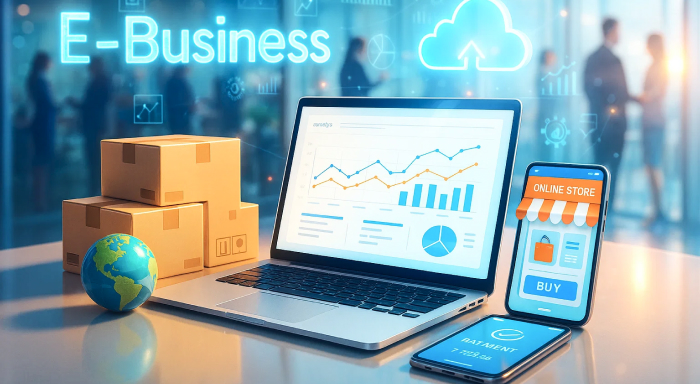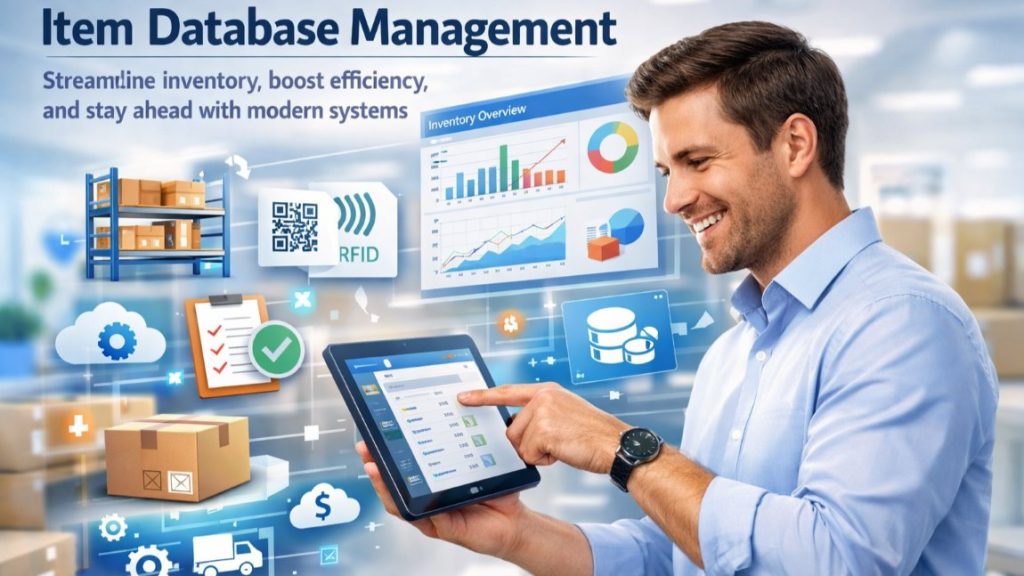In today’s digital world, doing business online is no longer just an option—it’s a must. E-business makes it easier for companies to sell products, offer services, and connect with customers
In today’s digital world, doing business online is no longer just an option—it’s a must. E-business makes it easier for companies to sell products, offer services, and connect with customers anytime, anywhere. From ordering groceries to booking services, we’re all part of this digital shift. This blog will help you understand what e-business really means, its benefits, challenges, and how you can get started if you're planning to take your business online.
What is E-Business?
E-business (electronic business) means carrying out business activities over the web, internet, extranet, or a combination of all three. Customer, internal, and management-oriented business processes include activities such as buying and selling goods and services, customer service, and payment processing. They also encompass production, supply chain management, business partner collaboration, and information sharing. Additionally, these processes involve operating automated staff services and hiring personnel.
E-business is like e-commerce but includes a lot more than web-based purchasing transactions. Tasks and services involve the creation of intranets and extranets, as well as providing e-services via the internet through application service providers. Businesses use e-business to purchase components and materials from other firms, partners for sales promotion, and perform joint research.
Advantages of E-business
Global Reach
E-business eliminates geographical barriers, allowing companies to reach customers worldwide without the need for physical presence in every market.
Cost Efficiency
Digital operations often require lower overhead costs compared to traditional brick-and-mortar businesses. Automated processes reduce labor costs and improve operational efficiency.
24/7 Availability
Online platforms operate continuously, allowing customers to interact with businesses at their convenience, leading to increased sales opportunities.
Data-Driven Decision Making
E-business generates vast amounts of data that can be analyzed to understand customer behavior, market trends, and operational performance, enabling more informed business decisions.
Scalability
Digital platforms can scale rapidly to accommodate growth without proportional increases in infrastructure costs.
Personalization
Advanced analytics and AI enable businesses to provide personalized experiences, recommendations, and targeted marketing messages.
Challenges in E-Business
The nature of challenges that are posed by electronic business differs from one business to another, contingent on a myriad of factors, among them whether the company was born digital, whether digital services drive the company's key value proposition, whether digital services are leveraged for e-business in just sections of the company's operations and whether the company has legacy technology. Regardless of the range of digital transformation, there are common elements present in e-business challenges, among which are the following:
Protecting e-business services from growing sophisticated cyber threats.
- Scaling services quickly enough to respond to demand without compromising performance.
- Adapting technologies quickly enough to keep up with shifting market forces.
- Discovering and training highly skilled workers to keep up with leading-edge technologies.
- Keeping up with e-business capabilities that, due to their electronic nature, are always available.
Moreover, most firms find it difficult to marry their fragmented data and functions and integrate e-business services to merge and harmonize with each other.
Different types of Businesses
Business-to-Consumer (B2C)
Companies sell directly to individual consumers through online platforms. Examples include Netflix, Spotify, and traditional retailers with an online presence. The business of education has also embraced this model, with platforms like Coursera and Udemy offering courses directly to learners worldwide.
Business-to-Business (B2B)
Companies conduct transactions with other businesses electronically. This includes wholesale marketplaces, software-as-a-service (SaaS) platforms, and industrial equipment suppliers.
Consumer-to-Consumer (C2C)
Platforms that facilitate transactions between individual consumers, such as eBay, Etsy, and peer-to-peer marketplaces.
Consumer-to-Business (C2B)
Models where individuals sell products or services to businesses, including freelance platforms like Upwork and influencer marketing.
Getting Started with E-Business
Organizations and companies are supposed to execute these steps while initiating an e-business:
Find a niche and business model: Conduct market research and consumer needs to find a profitable niche. Determine if the e-business involves retail, digital products, services or B2B business.
Formulate a business plan: Sketch important features of business operations, including target market, price policy, and SCM. An AI business plan generator can simplify this process by automatically structuring your ideas, analyzing market data, and generating a clear, professional plan in less time
Choose a Business Structure : Before you can register your e-business, it’s important to determine its legal structure. One popular option is an LLC, which offers a balance of legal protection and operational flexibility. Forming an LLC separates your personal assets from business liabilities and can provide tax advantages, depending on your location. For instance, forming an LLC in Texas comes with no state income tax, while in California, LLCs are subject to an annual franchise tax and minimum fees, making it essential to consider state-specific rules when choosing where to register your business.
Register the company and get necessary licenses: Depending on where one is, e-businesses are likely to need legal registration, tax identification numbers and industry-specific permits to conduct business lawfully.
Select an e-commerce platform: Pick a stable online platform to make shopping experiences easier. Hosted services, such as Shopify and WooCommerce, or custom-coded sites based on particular requirements are popular options.
Source products or services: If the business is running a retail-based e-business, it must obtain suppliers, manufacturers, or shipping partners. Service companies must create specific service packages and price structures.
Establish payment and security protocols: Introduce secure payment facilities, like PayPal, Stripe or credit card processing solutions. Achieving compliance with data security laws safeguards the business and its clients.
Make websites user-friendly: A website for an e-business should give a positive user and client experience, such as being mobile-friendly, fast-loading and easy to use.
Execute digital marketing tactics: Apply search engine optimization, social marketing and paid promotions to direct visitors to the e-business.
Set logistics and fulfillment procedures: For retail e-businesses, effective order fulfillment, shipping options and return policies determine customer satisfaction.
Watch performance and scale: Track sales, customer actions, and marketing performance using analytics tools. Continuous improvement and scalability measures assist in maintaining long-term growth in the competitive digital commerce market.
Conclusion
E-business is not merely a technological improvement – it's a radical transformation in how companies generate, provide, and capture value. Although it's risky, the potential for growth, efficiency, and innovation outweighs the threats for most organizations.
As the digital age advances, e-business will continue to evolve with the support of technological advancement and societal expectations. Those companies which recognize this change and keep their strategies fluid with the marketplace will find themselves in the best position to succeed within the marketplace.
Respond to this article with emojis






